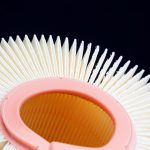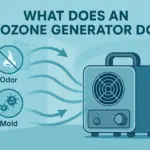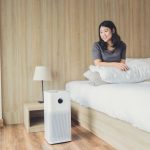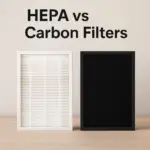An ozone machine, also called an ozone generator, works by creating ozone gas (O₃). The gas breaks down odors, mold, and bacteria, but only in empty spaces.
Table of Contents
🎥 Watch: Ozone Machines Explained
Learn what ozone generators really do, how to use them safely, and whether they’re right for your home.
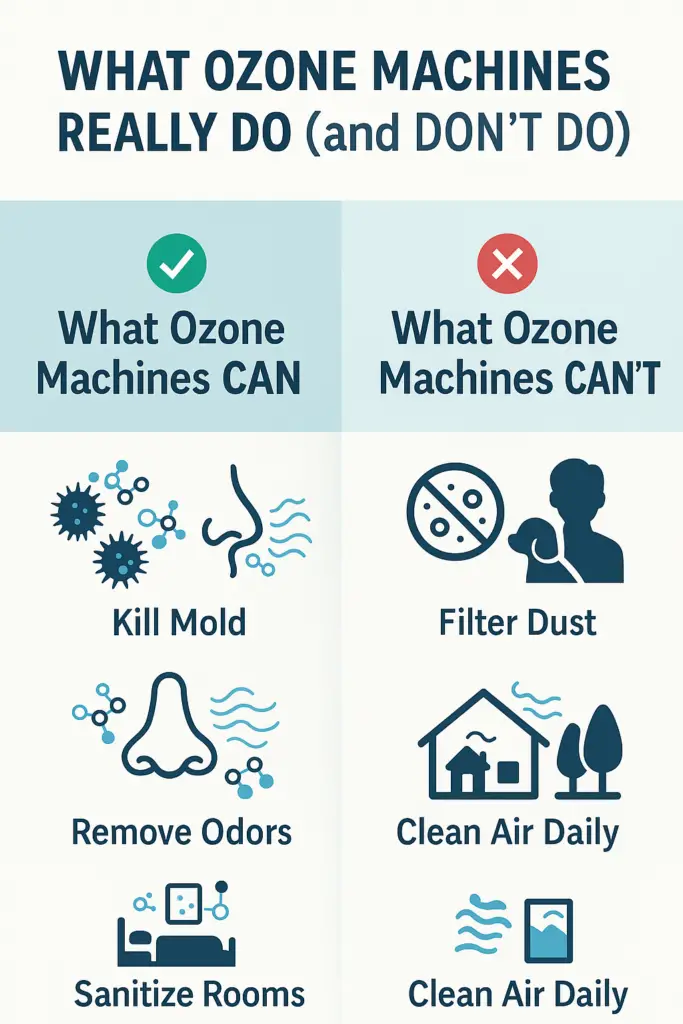
Still smelling smoke, mildew, or pet odor no matter how much you clean? That’s exactly what ozone machines are built for—deep, penetrating odor and bacteria removal that traditional cleaning methods can’t touch.
But here’s the catch: ozone generators aren’t magic, and they aren’t air purifiers. They don’t filter dust, and they can be dangerous if used the wrong way.
Is Ozone Safe—or Dangerous to Breathe?
Breathing ozone is harmful to both humans and animals—even at low levels. While ozone gas is excellent at sterilizing air and surfaces, it should never be used in occupied spaces.
Ozone is a reactive gas that irritates your lungs, throat, and nasal passages. When inhaled, it reacts with the lining of your respiratory tract, triggering inflammation, coughing, and reduced lung function.
Symptoms of ozone exposure include:
- Chest tightness or pain
- Shortness of breath
- Burning sensations in the eyes, nose, or throat
- Dry cough or wheezing
Children, older adults, and anyone with asthma or chronic respiratory issues are especially vulnerable.
Bottom line: Ozone machines should only be used in empty rooms and sealed-off spaces. Here’s how long to wait before re-entering a treated space.
Real-World Uses for Ozone Machines
Ozone machines aren’t meant for daily air cleaning—but when used properly, they can solve big problems that filters and sprays simply can’t touch. Here are the most common and effective ways people use ozone generators today:
- Odor Elimination: Ozone gas penetrates fabrics, cracks, and HVAC vents to eliminate tough smells like cigarette smoke, mildew, grease, or pet odor. Learn more about deodorizing your AC.
- Automobiles: Detailers and rental companies use ozone blasts to remove odors caused by smoking, spills, or long-term use. It’s one of the fastest ways to refresh a used vehicle.
- Hotels & Rentals: Used between guest stays to sterilize the air, kill odors, and even control insects like bed bugs. Great for high-traffic spaces.
- Animal Clinics & Dog Kennels: Helps sanitize kennels, vet offices, and grooming rooms. Be sure animals are removed before treatment!
- Gyms & Locker Rooms: A quick overnight ozone cycle helps eliminate bacteria from sweat and odor build-up in closed-air spaces.
- Rental Property Prep: Ozone is commonly used after water damage, smoke, or mold exposure—especially during house flipping. See how mold spores are treated with ozone.
- Water Treatment: Some systems use ozone to purify water by breaking down bacteria, pesticides, and chemicals—without leaving a chemical aftertaste.
Want to use ozone for pest control too? Here’s what you need to know.
What Happens If You Breathe in Ozone?
Even a small amount of ozone in the air can irritate your lungs—and the effects aren’t always instant. People often notice a burning feeling in their throat, chest tightness, or trouble breathing during or shortly after exposure.
Common symptoms include:
- Scratchy or burning throat
- Coughing or wheezing
- Chest pressure or discomfort
- Shortness of breath
- Watery eyes or nasal irritation
If you already have asthma, allergies, or any chronic respiratory condition, ozone exposure can make things worse quickly. But even healthy people may react to moderate or repeated exposure.
And here’s the kicker: ozone levels don’t have to be high to cause damage. That’s why organizations like the EPA and OSHA limit ozone exposure levels in workplaces and public spaces.
Bottom line? Ozone is a sterilizer, not a supplement. If you’re trying to purify air you plan to breathe, use a HEPA or UV system instead.
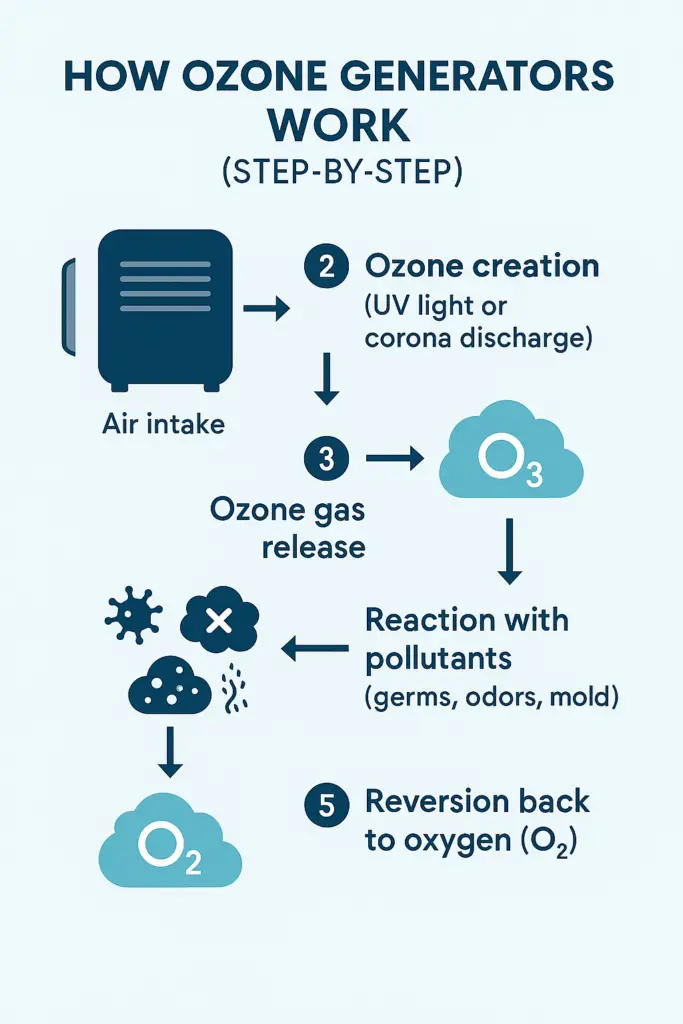
How Ozone Generators Work (and Why It Matters for Safety)
An ozone generator works by pulling in oxygen (O₂), splitting the molecules with UV light or corona discharge, and creating ozone (O₃). The ozone spreads into the room, reacts with pollutants like mold or bacteria, and then eventually breaks back down into oxygen.
Here’s how the process works:
- Air Intake: The machine pulls in regular air containing oxygen (O₂).
- Ozone Creation: Using either UV light or corona discharge, it splits oxygen molecules, creating ozone (O₃).
- Ozone Release: The gas is released into the room where it begins to spread and react.
- Oxidation Process: Ozone binds to pollutants (like mold, smoke, or bacteria), breaking them down at the molecular level.
- Back to Oxygen: After treatment, the unstable ozone reverts back to O₂, leaving behind “purified” air—if the process was done safely.
Important: This only works safely in an unoccupied space. Never run an ozone generator while people, pets, or plants are in the room.
Want to understand how this differs from air purifiers? Here’s how ozone breaks down over time.
Hidden Hazards of Ozone (When Used Improperly)
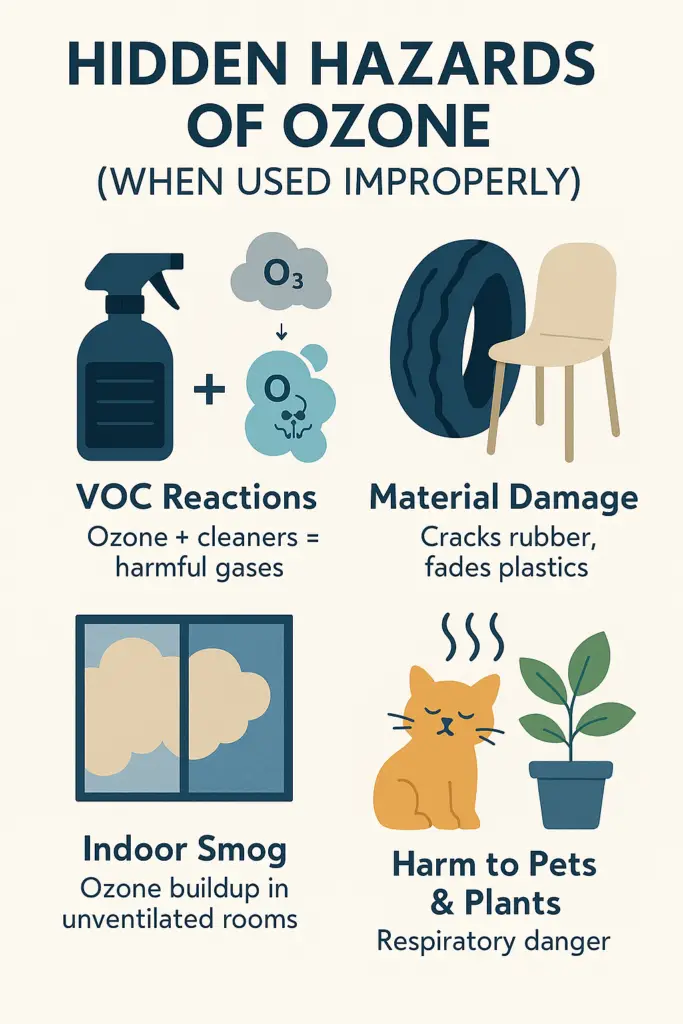
Ozone isn’t the enemy—improper use is. Because it’s such a reactive gas, ozone doesn’t only attack the mold or odors you’re targeting. It also interacts with chemicals, finishes, and materials in your home—sometimes with harmful results.
Here are some of the biggest risks to avoid:
- VOC Reactions: Ozone can react with volatile organic compounds (VOCs) from air fresheners, cleaning sprays, or paint—creating new, potentially toxic byproducts like formaldehyde or ultrafine particles. See how this can happen with common household cleaners.
- Material Damage: Ozone can degrade rubber, fade plastics, and dull painted finishes—especially when exposure is repeated or long-lasting.
- Indoor Smog: Poor ventilation during ozone use can lead to a foggy, harsh smell in the air—similar to outdoor pollution or smog.
- Harm to Pets & Plants: Animals (especially birds and cats) can experience severe respiratory stress, and houseplants may wilt or suffer cell damage after exposure. Ozone can disinfect air and remove odors, but it doesn’t eliminate every problem — like bed bugs. Here’s why ozone doesn’t work on bed bugs and what actually does.
These aren’t everyday outcomes—they’re signs of ozone being used too long, too often, or in the wrong space. Follow safe usage guidelines, and ozone can do its job without the side effects.
Why Do My Clothes Smell Like Ozone After Treatment?
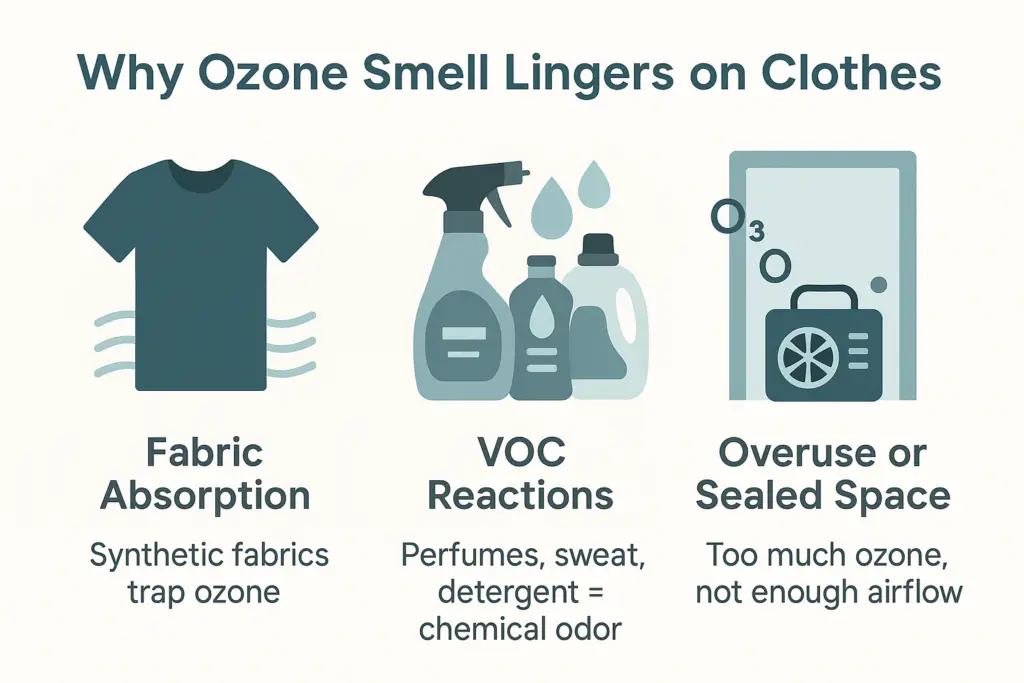
One of the most common side effects of ozone treatments is a strange smell that clings to clothes and fabrics—especially in bedrooms, closets, or carpeted rooms. It’s not dangerous, but it can be unpleasant or hard to get rid of.
Here’s why it happens:
- Fabric Absorption: Synthetic fabrics like polyester, nylon, and spandex tend to trap ozone more than natural fibers like cotton or wool.
- VOC Reactions: If your clothing has perfumes, deodorant, detergent residue, or body oils, ozone can react with those to create a lingering chemical smell.
- Too Much Ozone in a Sealed Space: Running the machine too long—or without airflow—can cause ozone to settle deep into porous fabrics.
Want to know what ozone actually smells like in the first place? Here’s what to expect from the scent.
How to Remove Ozone Smell from Clothes
If your clothes came out of an ozone-treated room smelling sharp, metallic, or like chlorine—don’t worry. You can usually get rid of the scent in just a few steps.
Try these methods:
- Air Them Out: Hang clothes outside in the sun for several hours. UV light and fresh air help neutralize leftover ozone compounds.
- Wash with Baking Soda or Vinegar: Add ½ cup of either to your laundry to break down odors naturally.
- Use Odor-Removing Laundry Boosters: Products like OxiClean™ or activated charcoal additives can help eliminate stubborn smells.
- Let Them Breathe After Washing: Don’t seal them up in drawers or closets until the smell is completely gone.
Pro Tip: If you’re using an ozone machine in a room with stored clothes, remove them first—or at least tape the closet doors shut to limit ozone exposure.
Still not gone after one wash? Just repeat the steps. The smell will usually fade within a day or two.
Final Takeaway — Use It Like a Treatment, Not a Purifier
Ozone machines are powerful tools for eliminating odors, mold, bacteria, and smoke damage—but they’re not meant for everyday air cleaning.
Think of ozone like a “chemical reset” for the air in your space. It doesn’t trap particles like a HEPA filter or work silently in the background like a UV-C light. It aggressively sterilizes a space, then breaks down and leaves no residue—if used correctly.”
Need help choosing between renting and buying? Here’s a full breakdown of when to rent an ozone machine vs. when to purchase one
Here’s how ozone stacks up against other common air-cleaning methods:
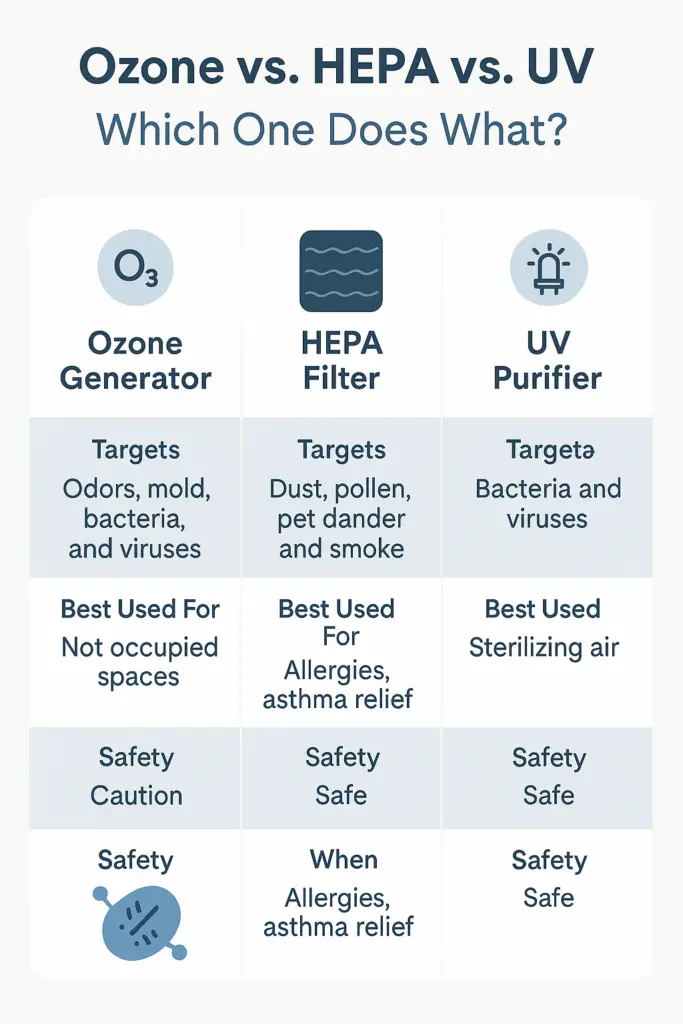
Use ozone generators when:
You’re flipping a rental, dealing with lingering odors, or disinfecting after a water leak or mold problem.
Use a HEPA or UV system when:
You want ongoing air purification for your home while people and pets are present.
Bottom line? Ozone isn’t for every day—but when you need a heavy-duty solution, it can do what nothing else can.
Frequently Asked Questions
What is an ozone machine?
An ozone machine (or ozone generator) creates ozone gas (O₃), which reacts with pollutants like smoke, bacteria, or mold to sterilize air and surfaces. Here’s how the process works step by step.
Is ozone safe to breathe?
No. Even low levels of ozone can irritate your lungs and worsen asthma or breathing problems. Never run one while people, pets, or plants are in the room. See how long to wait before reentering.
Is ozone the same as an air purifier?
No. Traditional air purifiers use filters (like HEPA) to trap particles, while ozone chemically alters pollutants. It doesn’t remove dust or allergens. Learn the difference between ozone and ionizers here.
What can I use ozone machines for?
They’re best for:
- Eliminating odors (smoke, mildew, pets)
- Sanitizing rooms after mold or water damage
- Flipping hotel rooms or rental properties
Some people also use ozone for pest control—see how effective it is.
Can ozone damage materials or leave a smell?
Yes. It can break down rubber, plastic, and fabric over time. It may also leave a sharp “metallic” or “chlorine” smell on clothes. Here’s what ozone smells like—and why it lingers.
How do I get ozone smell out of clothes?
Air them out, wash with vinegar or baking soda, and don’t seal them up right away. See the full step-by-step method.
Is ozone effective against mold and viruses?
Yes—when used at the proper dose. It can kill mold spores and deactivate many viruses, but only in high enough concentrations with nobody in the room. Compare this to UV HVAC options for mold control.
Can I be in a different room while it’s running?
No. Ozone seeps through cracks, air vents, and doors. Everyone should vacate the building during treatment for safety.
What do I need to do before running it?
Remove people, pets, and plants. Seal off rooms if needed. Set a timer. Then ventilate after.


